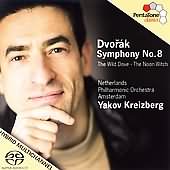|
You are reading the older HTML site Positive Feedback ISSUE september/october 2007
Antonin Dvorak, Symphony No.8
Plus The Wild Dove, The Noon Witch Netherlands Philharmonic Orchestra Amsterdam, Conducted by Yakov Kreizberg PentaTone SACD Hybrid PTC 5186 065 Dvorak's Symphony No.8 is an excellent composition and stiff competition for his slightly more popular Symphony No. 9, New World. That symphony contains some tunes, melodies and fragments from American sources collected by Dvorak during his three year stay in America. The symphony under review here is a bit under appreciated by some and others rank it above the more famous No. 9. Eight is rather compact, concise and to the point. Its melodies tend to be almost immediately appealing and often are simply sprightly. The orchestra/conductor combination is fully up to the task. The result is as good as it gets and it comes compared to more famous conductors and orchestras and in no way does it take a back seat to any other. To this must be added PentaTone's simply excellent sound quality. Unlike the overall quality in the accompany Nutcracker review, here the more forward, closer perspective is fully keeping with the overall character of the symphony. Natural, unforced details abound from the deep bass range through the all important midrange into the spatial defining overtones. This alone should be worth the price of admission. The revealing detail gives full and equal weight to the brass, winds and strings. PentaTone has gone further here by adding a very full half hour split between two relatively unknown symphonic poems by Dvorak. They are listed on the title page as the Noon Witch, Op. 108 and the Wild Dove, Op. 110. However, the liner notes refer to them as the Afternoon Witch and the Wood Dove. The Afternoon Witch is a ghostly tale told to frighten naughty children. The Wood Dove is a tale about a woman who poisons her husband and that a tree growing by his grave becomes home to a wood dove that coos and makes the woman think the sound is being made by her dead husband. These unusual stories and their respective inspired symphonic poems in no way over shadow the outstanding performance of Dvorak's Symphony No. 8. The symphony and its performance easily warrant a top recommendation. I am very pleased with the growing number of top recommendations being earned by many new releases. So often as here, the top recommendation is partly earned because of the very high audio quality presented by the advanced SACD layer of the disc. I want to make it clear that the extra quality, appreciated by audiophiles as well as music lovers, is abundantly clear in plain old stereo, using the multichannel is not necessary to appreciate the other areas of improved audio quality. I also want to make it perfectly clear that purchasing the SACD hybrid recordings and writing to the recording companies not offering them are necessities if the superior qualities of SACD are going to be available to us in the future. Do I really need to mention that most of the people involved in the business side of most recording companies really do not care about the higher quality of SACD recordings unless the profit margin increases as a result. For those of you relatively new to the world of classical music, I respectfully suggest sampling/purchasing of recordings of the following as expanded choices following this reviewed Dvorak recording. Symphony No. 9 (New World), Cello Concerto (my favorite) Serenade for Strings, Serenade for Winds and if the addition of a piano to chamber music attracts you as it does me, many of his chamber music compositions whether trio, quartet or quintet, beautifully add the expected fullness and richness of a fine piano. Those groups make for fine and logical combinations to be invited into your listening room! By contrast, sometimes those large orchestral groups of seventy to a hundred musicians all playing at the same time in your room, can seem to become a bit much of a crowd.
|

